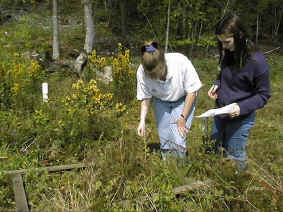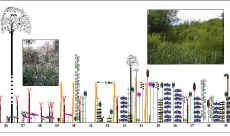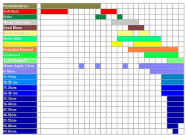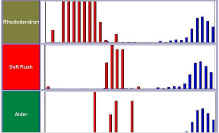|
| |
ECOLOGICAL SAMPLING METHODS
Contents
Which Method to Use?

| Stratified
Sampling? |
 |
| Stratified
sampling is simply the process of identifying areas within an overall habitat, which may
be very different from each other and which need to be sampled separately. Each individual
area separately sampled within the overall habitat is then called a stratum. The habitat
may be fairly uniform, in which case, this is unnecessary. More here |
 |
 |
| Random Sampling? |
Systematic
Sampling (Transects)? |
This is used where the
habitat being sampled is fairly uniform.
Example: The Woodland
Project
To remove observer bias in the
selection of samples.
Where statistical tests are to be
used which require randomly collected data.
Where a large area needs to be
covered quickly.
If time is very limited.
How many samples? |
- To
show zonation of species along some environmental gradient.
e.g. down a sea shore, across a woodland edge.
Example: The Wetland Survey
Where there is some kind of
continuous variation along a line,
e.g. across the Centre's heathland strips.
To sample linear habitats, e.g. a
roadside verge.
Where physical conditions demand it,
e.g. sampling a vertical rock face, using a rope to climb it.
|
Comparison of results
obtained using random & belt transect methods |
 |
| Systematic
Sampling - Line or Belt? |
 |
 |
| Line Transect? |
Belt Transect? |
|


|


|
What interval should be used?
Transects can either be continuous with the whole
length of the line being sampled, or samples can be taken at particular points along the
line. For example, every metre, or every other metre.
For both line and belt transects, the interval at which
samples are taken will depend on the individual habitat, as well as on the time and effort
which can be allocated to the survey.
Too great an interval may mean that many species
actually present are not noted, as well as obscuring zonation patterns for lack of
observations. More here
Too small an interval can make the sampling
extraordinarily time consuming, as well as yielding more data than is needed. This can
cause problems with presenting the data (line transects) as well as sometimes making it
harder to see patterns of zonation because of too much 'clutter'.
More here
It is important to make sure that the interval chosen
does not happen to coincide with some regularly occurring feature of the habitat. For
example, if sampling an old field with ridge and furrow systems still obvious, the
interval should not be such that all samples are taken on a ridge, or all the samples in a
furrow. (Unless, of course, the purpose of the survey is to identify any differences
between ridges and furrows!)
The ideal interval will be chosen by balancing the
complexity of the individual habitat with the purpose of the survey and the resources
available to carry it out. |
Ecological Sampling
Contents
|




